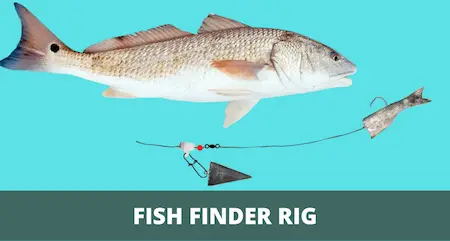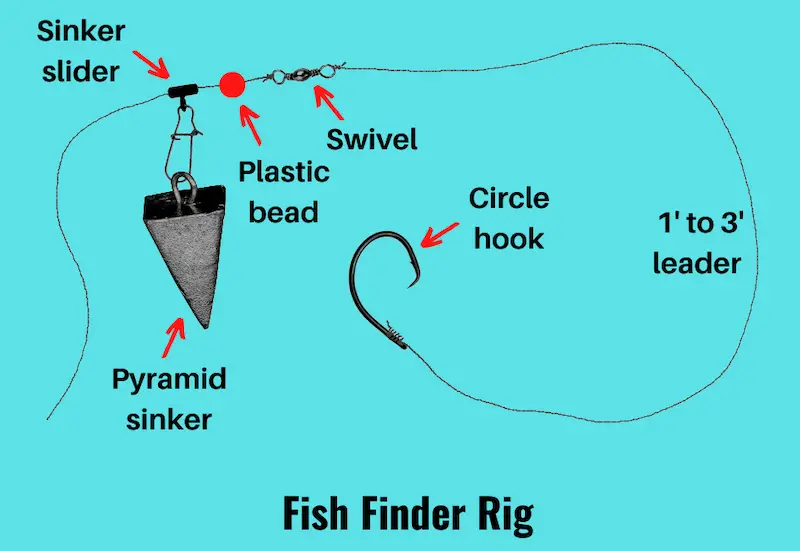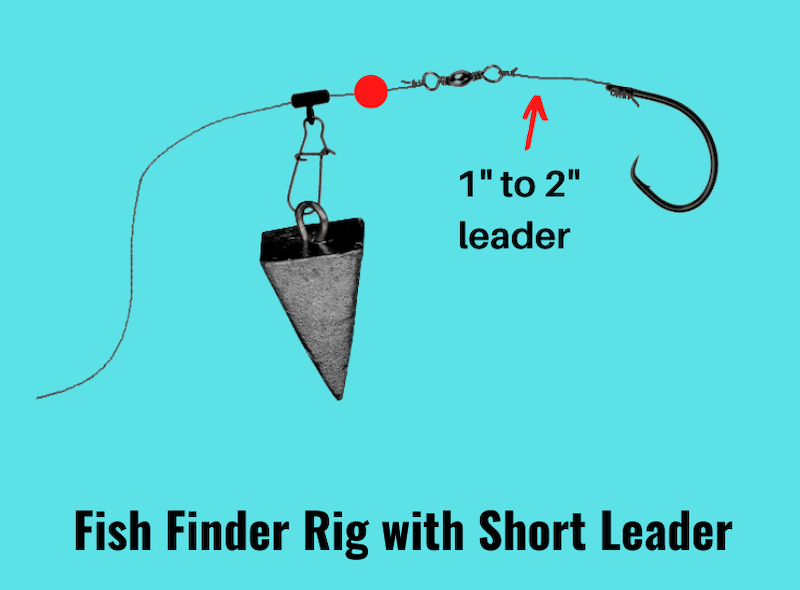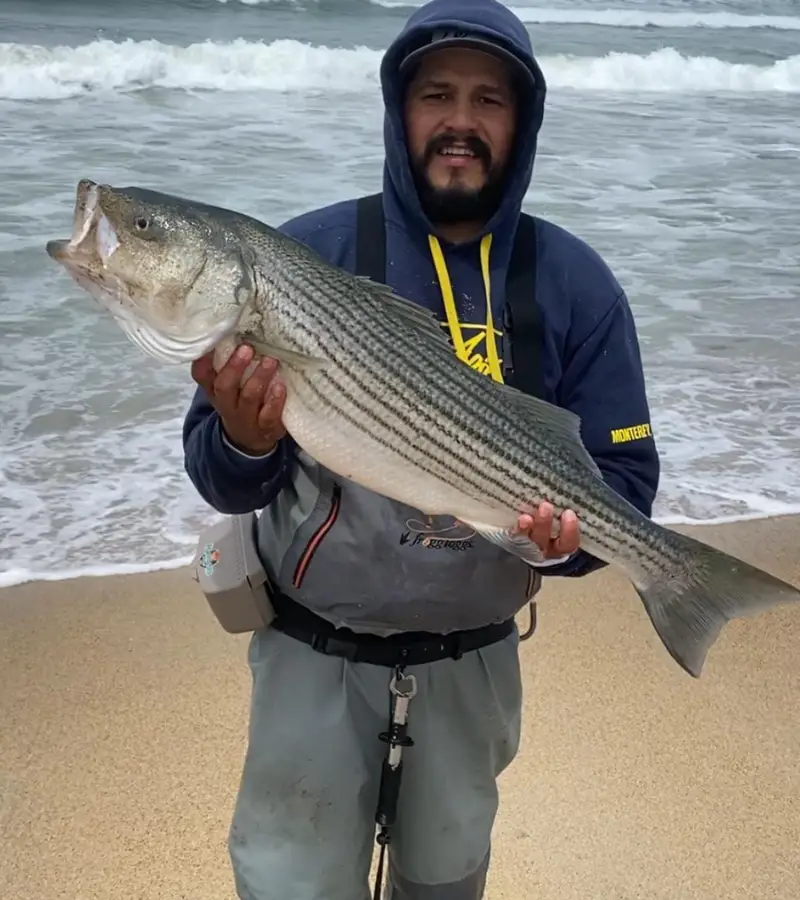Fish Finder Rig 101 (Setup & Fishing Guide with Pictures)
PUBLISHED 16 AUGUST 2023
by Robert Ceran
Are you planning to throw a fish finder rig, but aren’t sure how to set it up, or how to fish it for optimal results?
While the fish finder rig is one of the best rigs for surf fishing, it can be a little tricky to set up and fish correctly.
In this article I’ll explain how to set up a fish finder rig, and will aso cover what bait to use with it, and how to fish it to catch more fish.

What is a fish finder rig (and what is it good for)?
A fish finder rig is a bottom fishing setup that consists of a pyramid sinker riding on the main line using a sinker slide, as well as a leader tied to a circle hook.
The heavy pyramid sinker used for this setup is ideal for fishing in the challenging conditions encountered while beach fishing, as it can keep your rig in place even in the face of strong currents and breaking surf.
Because of this, the fish finder rig is one of the best surf fishing rigs, and is the go-to choice for most beach anglers targeting a wide variety of saltwater game fish, including striped bass, cobia, red drum, flounder, seat trout, snook, sheepshead, croaker, and even small sharks.
This rig is primarily used with cut bait, usually cut mullet, crab, squid, or bunker. It is not a great choice for fishing with live bait, as live bait tends to get torn off the hook during the long casts required for surf fishing.
Fish finder rig components
Here are the tackle components that you’ll need for fish finder rig setup:
- Pyramid sinker ( 3 to 4 oz)
- Sinker slider (size 5)
- Plastic bead (6 to 8 mm diameter)
- Swivel
- 40 to 100 lb test leader (mono, fluoro, or steel)
- Hook (size 4/0 to 6/0 circle hook)
- Foam peg float (optional)
In my experience, a fluorocarbon leader works well for most species caught with this setup on the beach, while steel is necessary if there’s a chance of hooking into sharks or other predatory fish with sharp teeth.

My preference for the main line is 50 to 60 lb test braided line, as that has the best casting properties, and creates less drag in the surf due to its thinner diameter, compared to other types of fishing line
The sinker slide should be high quality, as it has to withstand a lot of wear and tear in the surf. Now let’s discuss how to make the fish finder rig.
How to tie a fish finder rig
The first step is to thread your main line through the sinker slide, followed by the red bead, and then tying your main line to the swivel with a palomar knot or uni knot.
The plastic red bead protects the knot from the sinker slider, and prevents it from getting stuck on the knot.
Next, attach the pyramid shaped sinker to the snap of the sinker slide, and then tie the end of your leader line to the other eye of the barrel swivel.
Measure out 1 to 2 feet of leader, cut it off, and tie the tag end to the circle hook with a snell knot. Finally, bait your hook, and you’re good to go!
Choosing the right leader length
As a rule of thumb, the ideal leader length for a fish finder rig is 1 to 2 feet (12 to 24 inches). A longer leader can help when you target fish that are finicky, as it keeps your bait away from the sinker, and hence looks more natural.
However, if you’re surf fishing and want to achieve maximum casting distances with this setup, it’s better to shorten the leader. You can even go as short as 1 to 2 inches (see image below).

The short leader variant of this setup is a great option for long distance surf casting, since the short leader is less likely to “helicopter” and get tangled with the main line while the setup is flying through the air. This is a great rig for catching redfish in the surf.
In order to make sure your leader doesn’t get wrapped around the main line during the cast, it’s also a good idea to use a stronger leader material (70 lb test or more), which is stiffer than 40 lb test.
Pegging a float to your fish finder rig
In some cases you may want your bait to be presented floating above the bottom, rather than lying on top of it. This can be necessary if your bait is constantly being removed by scavenging crabs.
To do this, slide a foam float onto your leader before you tie on the hook, and use a peg to fasten it to the line. This allows the bait to float a few inches above the weight, while still staying near the bottom.
However, keep in mind that the bright color of the float may scare off finicky fish species, so I don’t recommend this setup unless it’s absolutely necessary.
What bait should you use with a fish finder rig?
The best bait to use with a fish finder rig is cut bait, using oily fish that releases scents into the water which attract fish. In general, it’s always best to use freshly caught fish, but failing that you can also get frozen fish in tackle shops or supermarkets.
The best fish species to use for cut bait include mullet, bunker, mackerel, croaker, and herring. Cut the fish into chunks that are about 1 to 2 inches long and wide. The nice thing about this kind of bait is that it catches a wide variety of saltwater fish.
How to fish a fish finder rig
The best places to use a fish finder rig for surf fishing are sandy beaches, since this setup performs well in areas with bare sand bottom without rocks, and without too much seaweed or seagrass.
The pyramid sinker of this bottom fishing rig tunnels into the sand, and gives your setup stability in the strong currents of the surf, which makes it ideal for sandy bottom, while it doesn’t work so well on rocky bottom.
If you’re fishing at a gently sloping beach, you may have to cast your rig over long distances in order to reach the fish. In that case shorten your leader (as described above).
Bait your hook with cut bait, cast your fish finder rig out into the surf, and place your surf rod in a rod holder and reel in enough line to keep the line taut.
After casting out your rig, all you need to do is watch the tip of your rod to detect bites, and reel in your setup every now and again, to replenish your hook with fresh bait.

Image source: instagram/@chicano_surfkaster
The great thing about the fish finder rig is that the sinker can slide on your line due to the sinker slider.
That way, when a fish takes the bait, it won’t feel the resistance of the weight. And as the fish eats the bait without feeling the sinker, you’ll notice the tip of your rod being pulled down towards the water.
That’s why you have to watch your surf fishing rods like a hawk when fishing with this setup, and when you see one of the rod tips being jerked down, quickly set the hook and fight the fish.
